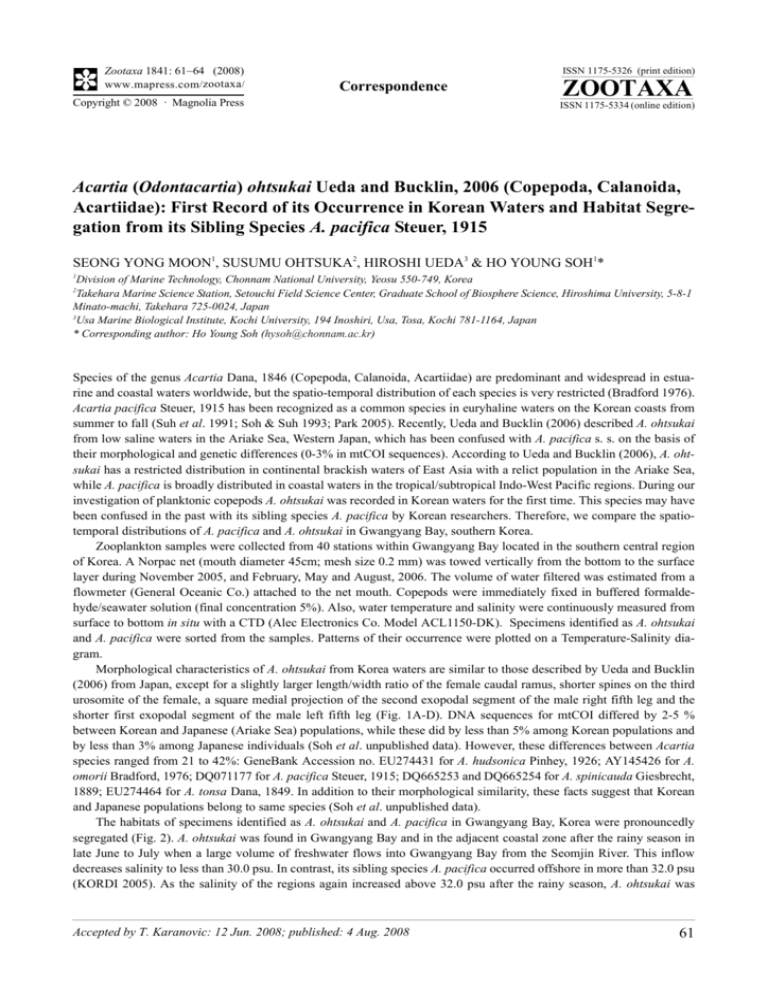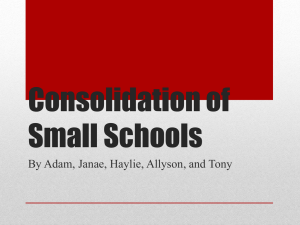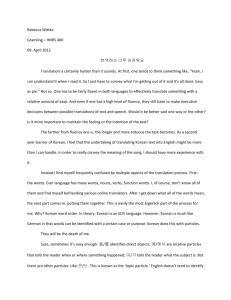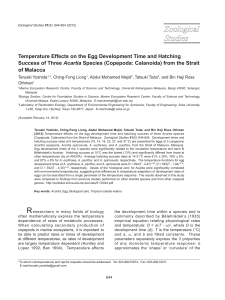Full article
advertisement

Zootaxa 1841: 61–64 (2008) www.mapress.com / zootaxa/ ISSN 1175-5326 (print edition) Correspondence Copyright © 2008 · Magnolia Press ZOOTAXA ISSN 1175-5334 (online edition) Acartia (Odontacartia) ohtsukai Ueda and Bucklin, 2006 (Copepoda, Calanoida, Acartiidae): First Record of its Occurrence in Korean Waters and Habitat Segregation from its Sibling Species A. pacifica Steuer, 1915 SEONG YONG MOON1, SUSUMU OHTSUKA2, HIROSHI UEDA3 & HO YOUNG SOH1* 1 Division of Marine Technology, Chonnam National University, Yeosu 550-749, Korea Takehara Marine Science Station, Setouchi Field Science Center, Graduate School of Biosphere Science, Hiroshima University, 5-8-1 Minato-machi, Takehara 725-0024, Japan 3 Usa Marine Biological Institute, Kochi University, 194 Inoshiri, Usa, Tosa, Kochi 781-1164, Japan * Corresponding author: Ho Young Soh (hysoh@chonnam.ac.kr) 2 Species of the genus Acartia Dana, 1846 (Copepoda, Calanoida, Acartiidae) are predominant and widespread in estuarine and coastal waters worldwide, but the spatio-temporal distribution of each species is very restricted (Bradford 1976). Acartia pacifica Steuer, 1915 has been recognized as a common species in euryhaline waters on the Korean coasts from summer to fall (Suh et al. 1991; Soh & Suh 1993; Park 2005). Recently, Ueda and Bucklin (2006) described A. ohtsukai from low saline waters in the Ariake Sea, Western Japan, which has been confused with A. pacifica s. s. on the basis of their morphological and genetic differences (0-3% in mtCOI sequences). According to Ueda and Bucklin (2006), A. ohtsukai has a restricted distribution in continental brackish waters of East Asia with a relict population in the Ariake Sea, while A. pacifica is broadly distributed in coastal waters in the tropical/subtropical Indo-West Pacific regions. During our investigation of planktonic copepods A. ohtsukai was recorded in Korean waters for the first time. This species may have been confused in the past with its sibling species A. pacifica by Korean researchers. Therefore, we compare the spatiotemporal distributions of A. pacifica and A. ohtsukai in Gwangyang Bay, southern Korea. Zooplankton samples were collected from 40 stations within Gwangyang Bay located in the southern central region of Korea. A Norpac net (mouth diameter 45cm; mesh size 0.2 mm) was towed vertically from the bottom to the surface layer during November 2005, and February, May and August, 2006. The volume of water filtered was estimated from a flowmeter (General Oceanic Co.) attached to the net mouth. Copepods were immediately fixed in buffered formaldehyde/seawater solution (final concentration 5%). Also, water temperature and salinity were continuously measured from surface to bottom in situ with a CTD (Alec Electronics Co. Model ACL1150-DK). Specimens identified as A. ohtsukai and A. pacifica were sorted from the samples. Patterns of their occurrence were plotted on a Temperature-Salinity diagram. Morphological characteristics of A. ohtsukai from Korea waters are similar to those described by Ueda and Bucklin (2006) from Japan, except for a slightly larger length/width ratio of the female caudal ramus, shorter spines on the third urosomite of the female, a square medial projection of the second exopodal segment of the male right fifth leg and the shorter first exopodal segment of the male left fifth leg (Fig. 1A-D). DNA sequences for mtCOI differed by 2-5 % between Korean and Japanese (Ariake Sea) populations, while these did by less than 5% among Korean populations and by less than 3% among Japanese individuals (Soh et al. unpublished data). However, these differences between Acartia species ranged from 21 to 42%: GeneBank Accession no. EU274431 for A. hudsonica Pinhey, 1926; AY145426 for A. omorii Bradford, 1976; DQ071177 for A. pacifica Steuer, 1915; DQ665253 and DQ665254 for A. spinicauda Giesbrecht, 1889; EU274464 for A. tonsa Dana, 1849. In addition to their morphological similarity, these facts suggest that Korean and Japanese populations belong to same species (Soh et al. unpublished data). The habitats of specimens identified as A. ohtsukai and A. pacifica in Gwangyang Bay, Korea were pronouncedly segregated (Fig. 2). A. ohtsukai was found in Gwangyang Bay and in the adjacent coastal zone after the rainy season in late June to July when a large volume of freshwater flows into Gwangyang Bay from the Seomjin River. This inflow decreases salinity to less than 30.0 psu. In contrast, its sibling species A. pacifica occurred offshore in more than 32.0 psu (KORDI 2005). As the salinity of the regions again increased above 32.0 psu after the rainy season, A. ohtsukai was Accepted by T. Karanovic: 12 Jun. 2008; published: 4 Aug. 2008 61 replaced by A. pacifica; at this time A. ohtsukai was restricted in its distribution to the Seomjin River estuary. Both species were absent from those areas where the water temperature was lower than 12 oC (Fig. 2). FIGURE 1. Acartia ohtsukai (Ueda and Bucklin, 2006). Female (A) Habitus, dorsal view; (B) leg 5; Male (C) habitus, dorsal view; (D) leg 5. Scale bars A,C = 200 , B,D = 50 ; r, right leg; l, left leg. Acartia ohtsukai has been recorded in brackish waters along the coasts of the Northwest Pacific (Brodsky 1948, 1950; Chen & Zhang 1965; Zheng et al. 1965; Ueda & Bucklin 2006), while A. pacifica occurs in high salinity of coastal regions in the Indo-West Pacific (Tanaka 1965; Ueda & Bucklin 2006; present study). The former species (Park 2005, as A. pacifica) has been reported as the predominant species within the Seomjin River estuary during summer characterized by low salinity and high temperature, while the latter is confined to coastal regions (Soh & Jeong 2003). Furthermore, A. 62 · Zootaxa 1841 © 2008 Magnolia Press MOON ET AL. ohtsukai (see Park 2005, as A. pacifica) usually occurs together with brackish calanoid copepods Sinocalanus tellenus Kikuchi, 1928 and Tortanus derjugini Smirnov, 1935 and/or T. dextrilobatus Chen & Zhang, 1965 in the estuarine waters of Korea. FIGURE 2. Temperature-salinity-abundance diagram for A. ohtsukai and A. pacifica. Abundance (ind./m3) of each species is estimated by multiplying numbers on scale by 102 for A. ohtsukai (black circle) and A. pacifica (white circle). Within the last half century, many brackish and coastal copepods have been introduced by ballast water into habitats beyond their natural contemporary range (cf. Bollens et al. 2002). However, we do not think that this is the case for A. ohtsukai, because this species appears to have a natural distribution in East Asian continental waters from Russia to China (Ueda & Bucklin 2006). The occurrence of A. ohtsukai in the Ariake Sea (Japan) also was considered natural by Ueda and Bucklin (2006), as a continental relict similar to brackish calanoid copepods Sinocalanus sinensis (Poppe, 1889) and Tortanus derjugini/T. dextrilobatus. We express our sincere thanks to Prof. Y.H. Yoon and Drs. S.D. Choi and Y.J. Kim for their dedicated supports to complete our manuscript. This study was supported by grants of the Korea-Japan Basic Scientific Cooperation Program between the Korea Science and Engineering Foundation (F01-2005-000-10074-0) and the Japan Society for the Promotion of Science, and from the Ministry of Environment, Japan (Global Environment Research Fund D-072). References Bollens, S.M., Cordell, J.R., Avents, S. & Hooff, R. (2002) Zooplankton invasions: a brief review, plus two case studies from the northeast Pacific Ocean. Hydrobiologia, 480, 87–110. Bradford, J.M. (1976) Partial revision of the Acartia subgenus Acartiura (Copepoda: Calanoida: Acartiidae). New Zealand Journal of Marine and Freshwater Research, 10, 159–202. Brodsky, K.A. (1948) Svobodnozhivushchie veslonogie rachki (Copepoda) Yapanskogo morya. Izvestiya Tikhookeanskogo Instituta Rybnogo Khozyaistiva i Okeanografii, 26, 3–130, pls. 1–32 (In Russian). Brodsky, K.A. (1950) Calanoida of the Far Eastern Seas and Polar Basin of the USSR, Keys to the Fauna of the USSR, 35, 440 pp. (Translated from Russian by Israel Program for Scientific Translations, Jerusalem, 1967) Chen, Q.C. & Zhang, S.Z. (1965) The planktonic copepods of the Yellow Sea and the East China Sea, I. Calanoida. Studia Marina Sinica, 7, 20–131. (in Chinese) ACARTIA OHTSUKAI IN KOREAN WATERS Zootaxa 1841 © 2008 Magnolia Press · 63 KORDI (Korea Ocean Research & Development Institute) (2005) Studies on the development of Jeonnam archipelago marine ranching program in Korea. Ministry of Maritime Affairs & Fisheries, Seoul. pp. 110–138. (in Korean with English summary) Park, E.O. (2005) Seasonal change of copepod populations in the brackish water of the Seomjin River and Mangyeong River. Ph.D. thesis, Chonnam National University, 63 pp. (in Korean with English summary) Soh, H.Y. & Jeong, H.G. (2003) Spatio-temporal distribution of the genus Acartia (Copepoda: Calanoida) in southwestern waters of Korea. Korean Journal of Environmental Biology, 21, 422–427. Soh, H.Y. & Suh, H.-L. (1993) Seasonal fluctuation of the abundance of the planktonic copepods in Kwangyang Bay. Korean Journal of Environmental Biology, 11, 26–34. (in Korean with English summary) Suh, H.-L., Soh, H.Y. & Cha, S.S. (1991) Salinity and distribution of zooplankton in the estuarine system of Mankyeong River and Dongin River. Journal of Korean Society of Ocenography, 26, 181–192. (in Korean with English abstract) Tanaka, O. (1965) The pelagic copepods of the Izu region,middle Japan. Systematic account XIII. Families Parapontellidae, Acartiidae and Tortanidae. Publications of the Seto Marine Biological Laboratory, 12, pp. 379–408. Ueda, H. & Bucklin, A. (2006) Acartia (Odontacartia) ohtsukai, a new brackish-water calanoid copepod from Ariake Bay, Japan, with a redescription of the closely related A. pacifica from the Seto Inland Sea. Hydrobiologia, 560, 77– 91. Zheng, Z., Zhang, S., Li, S., Fang, J.C., Lai, R.Q., Zhang, S., Li, S.Q. & Xu, Z.Z. (1965) Marine planktonic copepods of China, 1. Shanghai Scientific and Technical Press, Shanghai, 211pp. (in Chinese) 64 · Zootaxa 1841 © 2008 Magnolia Press MOON ET AL.






